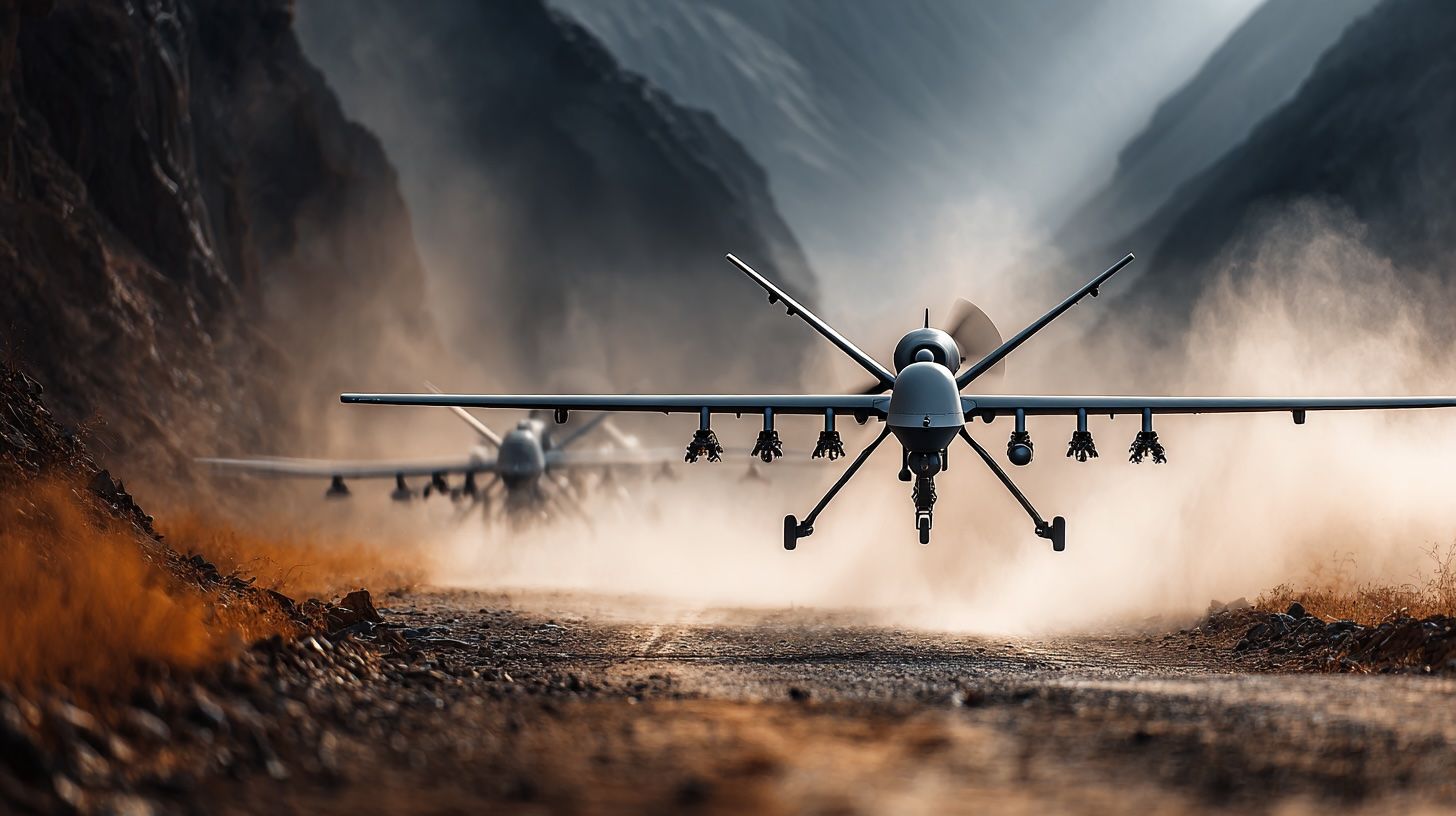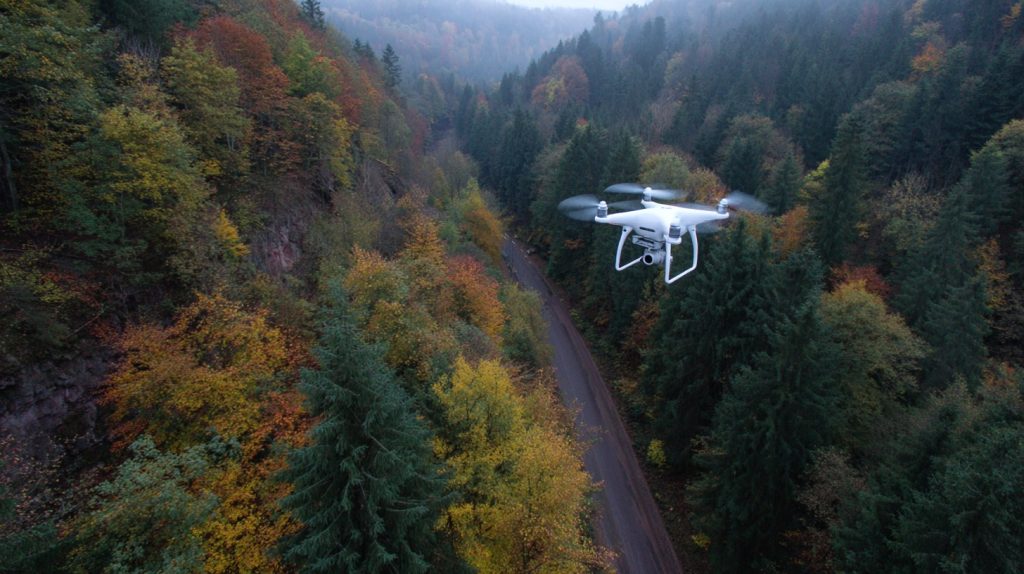- From 2006 to 2023, violent non-state actors carried out 1,122 drone attacks, with a peak of 265 in 2023.
- The 2018 Gatwick airport incident highlighted the public-safety risks posed by off-the-shelf quadcopters.
- The Ukraine war has been described as the first “drone war,” with both sides deploying swarms of small drones for surveillance and strikes, and in 2023 the U.S. supplied Ukraine with VAMPIRE kits (vehicle-mounted laser-guided rockets) for drone defense.
- Counter-drone systems use a layered approach—radar, RF, EO/IR, and acoustic sensors—with Fortem DroneHunter using compact R20 and R30 radars to spot small UAS out to several kilometers.
- RF detection can identify a drone by its signals and even distinguish models (e.g., DJI Phantom vs. Parrot) and estimate the pilot’s location.
- RF jamming is a core tactic that can force drones to lose link or land, but can also disrupt nearby systems like Wi-Fi or cell networks.
- RF spoofing or cyber takeover, as with D-Fend Solutions’ EnforceAir, can hijack a drone and land it safely, though encryption and anti-takeover measures can impede it.
- Directed-energy weapons are maturing, with 50 kW lasers on Stryker vehicles, Israel’s Iron Beam, the UK’s DragonFire, and Epirus’ Leonidas HPM system.
- Kinetic defenses include nets and interceptor drones like Fortem DroneHunter and Anduril Anvil (5 kg warhead) with Anvil-M, plus APKWS II rockets; in 2022 a Saudi downing of a Houthi drone caused 12 injuries.
- The global anti-drone market is expected to reach $10–15 billion by 2030 (25–28% CAGR), with North America holding over 50% of the market in 2024, and the U.S. Army awarding a $237 million C-UAS contract in 2023.
The Rising Threat of Drones in Modern Warfare and Public Security
Drones as Emerging Threats: Small unmanned aerial systems (UAS) have rapidly become a double-edged sword – offering benefits for civilians while introducing new threats on battlefields and in public spaces [1] [2]. Terrorist organizations and insurgents have weaponized cheap commercial drones for bombings, kamikaze strikes, and reconnaissance, often with devastating effect [3] [4]. In recent years, violent non-state actors like ISIS, Hamas, and Yemen’s Houthi rebels have carried out hundreds of drone attacks – a study counted 1,122 such incidents from 2006–2023, with an annual peak of 265 attacks in 2023 [5]. Nation-states are adopting similar tactics; the ongoing war in Ukraine has been called the first “drone war,” with both sides deploying swarms of small drones for surveillance and strikes, forcing defenders to scramble for countermeasures [6].
Public Safety Concerns: It’s not just warzones – rogue drones are creating headaches in peacetime settings as well. In recent years, drones have harassed airports and bedeviled local police, trespassing over sensitive sites like nuclear plants and prisons [7]. High-profile incidents – from drones shutting down major airports (e.g. the 2018 Gatwick incident) to an attempted drone assassination of a head of state – highlight how easily accessible quadcopters can threaten public safety. On the battlefield, even off-the-shelf drones “can kill,” delivering grenades or acting as loitering munitions [8]. Yet until recently, outside of physically shooting them down (which carries risks of its own), there was often little authorities could do to stop a malicious drone [9]. This rising drone threat has catalyzed a new arms race in counter-drone (C-UAS) technologies, as militaries, law enforcement, and security agencies seek effective ways to detect and defeat hostile drones.
Counter-Drone Technologies: Radar, Jammers, Lasers and More
Modern counter-UAS systems employ a variety of sensors and countermeasures – no single “silver bullet” solution exists [10]. Instead, a layered approach combines multiple technologies to detect, track, and neutralize drones of different sizes in different scenarios. Key components of C-UAS technology include:
Radar and Multispectral Detection
Traditional radar is a backbone of drone detection. Specialized counter-drone radars can pick up the small radar cross-section of hobbyist drones and track their flight path [11]. For example, systems like Fortem’s DroneHunter use compact radars (R20, R30, etc.) to spot small UAS out to several kilometers [12]. Radar is often combined with electro-optical (EO) and infrared (IR) cameras and even acoustic sensors for a multisensor approach [13] [14]. An advanced system might cue a camera or “acoustic camera” (an array of microphones) to visually identify a target once radar detects it [15]. This multispectral sensor fusion helps distinguish drones from birds or other objects. The integration of AI algorithms further improves detection accuracy – AI-enabled systems analyze radar/EO/IR data and flight patterns to reduce false alarms by telling a drone apart from, say, a bird [16]. In short, layered sensing (radar + RF + optical + acoustic) provides robust early warning of drone intrusions, feeding data into command systems for threat evaluation.
RF Detection and Drone Identification
Most drones rely on radio frequency links – either a remote control link or GPS signals – which can be exploited for detection. RF scanners and direction-finding antennas constantly sniff the spectrum for the unique communication signals between drone and operator [17] [18]. Once a drone’s control frequency is detected, a C-UAS system can often identify the drone type by its signal signature (e.g. distinguishing a DJI Phantom vs. a Parrot drone) and sometimes even approximate the pilot’s location. This passive detection is covert and can work in environments where radar may struggle (e.g. cluttered urban areas). Advanced RF cyber defenses also monitor Global Navigation Satellite System (GNSS) bands to detect attempts at GPS guidance [19]. However, as drone technology evolves, not all drones emit easily detectable RF – some autonomous or pre-programmed drones might fly without constant control signals, reducing the effectiveness of pure RF detection [20]. Thus, RF scanners are typically one layer in a multi-sensor C-UAS toolkit.
Jamming and Electronic Disruption
Radio jamming is one of the most common countermeasures and falls under the banner of electronic warfare (EW). High-powered jammers flood the drone’s control frequencies or GPS bands with noise, effectively severing the link between the drone and its operator or confusing its navigation. In practice, a well-timed RF jam can force a drone to shut down or enter “lost link” mode, causing it to hover or land immediately [21]. This technique is highly effective and technically straightforward, and many military forces have deployed portable or vehicle-mounted jammers as a first line of defense [22]. However, jamming is a blunt instrument – it doesn’t discriminate and can inadvertently disrupt other critical systems in the area [23]. For example, an anti-drone jammer might also knock out nearby Wi-Fi, police radios, cell phones, or even airport control tower communications [24]. Moreover, adversaries are adapting: some drones now operate on frequencies or methods resilient to basic jamming, and one-way attack drones (pre-programmed kamikaze drones) have no active control link to jam at all [25]. Despite these drawbacks, RF jamming remains a core C-UAS tactic, especially in warzones – battlefield reports from Ukraine indicate heavy Russian reliance on jammers to blunt Ukrainian drone operations [26].
Spoofing and Drone Hijacking
A counter-drone control station interface (D-Fend Solutions EnforceAir) displays a detected rogue drone and offers a “Take Over” option. Such systems execute a “cyber takeover”, hijacking the drone’s link to safely land it under friendly control [27] [28].
Not all electronic warfare against drones is brute-force jamming. An increasingly sophisticated approach is RF spoofing or protocol hacking, essentially hijacking the drone. This involves sending carefully crafted signals to impersonate the drone’s controller or manipulate its onboard navigation. For example, Israeli firm D-Fend’s EnforceAir system can hack into a drone’s control link and take over its controls, forcing it to land safely in a designated area [29] [30]. In a live demo, EnforceAir detected an intruding drone, then remotely commandeered and landed it with the push of a button [31]. The advantage of this method is precision – the drone can be brought down intact, allowing for forensic analysis or simply returned to a clueless hobbyist in case of a mistake [32]. It also avoids the collateral interference of broad jamming. However, spoofing/hacking is not foolproof: military-grade drones often employ encrypted links and anti-takeover safeguards that make them much harder to hijack [33]. Still, as a non-kinetic, low-collateral solution, cyber takeover tech is gaining traction for sensitive environments (e.g. airports, stadiums) where shooting drones out of the sky is undesirable. It’s essentially fighting drones by out-hacking them – an approach likely to grow with advances in software-defined radios and drone communications.
Directed Energy Weapons (Lasers and Microwaves)
One of the more futuristic (but rapidly maturing) counter-drone tools is the use of directed energy weapons:
- High-energy lasers (HEL) can be aimed to burn through a drone’s airframe or blind its sensors in seconds. Lasers offer the benefit of light-speed engagement and an effectively unlimited “magazine,” making them attractive for swarms of small drones. The U.S. Army and other militaries have tested 10–50 kW lasers mounted on vehicles that successfully shot down drones in mid-air during trials. For instance, the UK’s DragonFire laser demonstrator recently achieved a first-ever drone shoot-down with a high-power laser [34]. Israel has deployed a prototype laser air defense system (“Iron Beam”) reportedly to destroy UAVs and rockets in flight [35].
- High-power microwave (HPM) systems, on the other hand, emit bursts of microwave energy to fry a drone’s electronics or disrupt its guidance. These act like a localized EMP (electromagnetic pulse). Companies like Epirus (US) have fielded HPM devices (e.g. Leonidas) that in testing have disabled swarms of drones simultaneously by burning out circuits. Such systems are useful against groups of drones where a single laser might be overwhelmed.
Directed energy promises instant, low-cost per-shot defense, but also has limitations: lasers can be hindered by rain or smoke, and both lasers/HPM require substantial power and cooling to operate. Still, several nations are fast-tracking directed-energy C-UAS – for example, the U.S. is integrating a 50 kW laser on Stryker vehicles as part of its maneuver forces’ anti-drone arsenal [36]. As the technology improves, silent, invisible beams could become a staple for drone defense, complementing the more conventional methods.
Kinetic Interception (Guns, Nets and Interceptor Drones)
The most straightforward way to stop a drone is still to physically hit it or disable it. These “kinetic” defenses span a wide range:
- Projectile Weapons: Traditional anti-aircraft guns down to shotgun-style rounds have been used to shoot drones. Specialty munitions (like SkyKnight 40mm air-burst shells or even shoulder-fired net grenades) can blast swarms of drones. One novel example is the use of laser-guided 70mm rockets (APKWS II) fired from fighter jets to shoot down hostile drones cheaply [37] [38] – an innovation the U.S. Air Force employed to counter drone attacks in the Middle East. The challenge with bullets and missiles is risk of stray fire or debris, especially in civilian areas. In 2022, when Saudi defense forces shot down a Houthi drone with a missile, falling debris injured 12 people on the ground [39], illustrating the collateral dangers.
- Nets and Capture Devices: To avoid explosions, some systems opt to ensnare drones in nets. Anti-drone net guns can be shoulder-fired or mounted on other drones. For instance, startup OpenWorks’ SkyWall system fires a canister that deploys a net over a rogue drone, tangling its rotors. Similarly, Fortem Technologies’ DroneHunter F700 is an interceptor UAS that autonomously chases enemy drones and launches a net to capture them mid-air [40] [41]. Captured drones can then be parachuted to the ground safely [42]. Net captures eliminate the risk of fragments and allow recovery of the drone intact, though they require precise aiming or autonomous guidance.
- Interceptor Drones (“Drone-on-Drone” Defense): In what looks like sci-fi dogfights, specialized counter-drones can ram or destroy rogue drones. One high-profile example is Anduril Industries’ Anvil interceptor. The original Anvil is a small, fast quadcopter designed to kamikaze into hostile drones, literally knocking them out of the sky. At a recent defense expo, Anduril unveiled the Anvil-M variant carrying a small explosive warhead, which can fly into an enemy drone and detonate to ensure a kill [43]. The 5 kg Anvil has proven able to eliminate drones up to Group 2 size (~50 lbs) by direct impact or blast [44]. Such interceptors are usually guided by AI-enabled targeting systems (often leveraging the sensor network mentioned earlier). They excel in situations where electronic means fail – for example, if an incoming drone is on a pre-programmed path immune to jamming, a physical interceptor is the last line of defense [45]. Major armies are now investing in these “hard kill” drone-on-drone systems for base protection.
Each kinetic approach has trade-offs in cost, risk, and complexity. As one U.S. Army C-UAS officer put it, “jam them, hijack them, hit them with lasers, or knock them down kinetically – each option isn’t suitable for every occasion”, which is why a layered defense combining methods is considered best practice [46] [47].
Table 1: Key Counter-Drone Technologies & Examples
| Technology/Method | Purpose & Approach | Examples of Systems |
|---|---|---|
| Radar & EO/IR Sensors | Detect and track drones via radar signature, cameras, infrared, or acoustics. Often the first layer of detection. | Blighter A422 radar (UK) in AUDS; Squarehead Discovair acoustic sensor [48]; FLIR thermal cameras. |
| RF Detection | Scan for drone radio control or GPS signals to identify and locate UAS. | Dedrone RF-160 network; DroneShield RfOne receivers; (finds control links). |
| Jamming (RF/GNSS) | Disrupt drone’s control or navigation signals with electromagnetic interference, forcing it to crash or land. | DroneShield DroneGun Tactical (rifle jammer); Russian R-330Zh “Zhitel” jammer [49]; various vehicle-mounted jammers. |
| Spoofing/Takeover | Hack or spoof the drone’s link to take control or misguide it (e.g. fake GPS signals). | D-Fend EnforceAir (cyber takeover) [50]; US Army CELLDAR GPS-spoofing; Sentrycs Horizon system (AI-driven takeover). |
| Directed Energy (Laser/HPM) | Use high-energy lasers to burn drones or high-power microwaves to fry electronics, with no munitions needed. | Raytheon HEL (50kW laser on Stryker); Israel’s “Iron Beam” laser; Epirus Leonidas HPM system (counter-swarm). |
| Kinetic Interceptors | Physically destroy or capture drones using projectiles, nets, or interceptor drones. | Fortem DroneHunter (net capture) [51]; Anduril Anvil interceptor drone [52]; SkyWall net gun; RTX Coyote Block 2 loitering munition. |
Electronic Warfare Capabilities in Counter-Drone Operations
Electronic warfare (EW) has emerged as a linchpin of counter-drone strategy on the modern battlefield. By exploiting the electromagnetic spectrum, EW measures can detect, jam, and even directly control enemy drones. On the detection side, military EW units deploy sophisticated receivers to sense the faint signals of drones – from the uplink commands sent by an operator to the downlink video feed. These sensors, often networked with radar and other intelligence sources, help build a real-time picture of drone threats. For instance, armies have fielded portable direction-finders that pinpoint an enemy drone pilot’s position by their radio emissions, turning the tables on the hunter.
On the defeat side, EW provides multiple non-kinetic options: the most common is still jamming, as discussed, which falls under electronic attack. Battlefield EW systems like Russia’s truck-mounted R-330Zh “Zhitel” and Krasukha-4 can jam drone control frequencies and even satellite navigation over wide areas [53] [54]. In the Ukraine war, Russia reportedly has over 30 different EW systems dedicated to countering drones, GNSS, and communications [55] – these range from portable jammers troops carry, nicknamed “Stupor” rifles, to large systems that blanket multiple kilometers. Ukraine has responded by developing its own EW tools (such as the new “Patelnya” backpack jammer that creates a 360° drone “shield” around soldiers [56] [57]). Electronic warfare has, in effect, become electronic “artillery” against drones, and both sides in conflicts are racing to outdo each other’s EW capabilities.
However, electronic countermeasures provoke counter-countermeasures. Well-funded militaries are improving drone resilience: encrypting links, frequency-hopping to avoid jammers, and using autonomy to reduce reliance on communications. For example, faced with heavy Russian jamming, Ukrainian drone operators have in some cases switched to line-of-sight or pre-programmed flight modes [58] [59]. In turn, Russia adapted by intensifying GPS spoofing – emitting fake navigation signals to mislead UAVs – and even resorting to low-tech tricks like camouflage (placing tires on aircraft to confuse drone AI targeting [60]). This cat-and-mouse dynamic shows how central EW is in counter-drone warfare: it’s a constant battle of the algorithms and waveforms. Real-world results from Syria, Ukraine, and elsewhere indicate that strong EW defenses can significantly degrade drone effectiveness – many drones are lost to jamming-induced crashes or by being driven off-course. But when drones are programmed to ignore RF control (so-called “one-way” attack drones), physical or laser defenses must finish the job [61].
Importantly, electronic warfare systems are increasingly integrated into comprehensive C-UAS suites. A prime example is the U.S. Army’s “Howler” system, which pairs an advanced RF sensor (Ku-band radar) with an EW jammer and the Coyote interceptor to cover the full kill chain [62] [63]. In essence, EW acts as both a scout (detecting drones by their signals) and a sharpshooter (taking them out via jamming or hacking). As drone threats evolve, investment in EW – from software-defined radios that can rapidly adapt, to AI that can identify new enemy signal patterns – will remain a key pillar of counter-drone operations.
Ukrainian soldiers deploy the compact “Patelnya” electronic warfare system (“frying pan”), a 50W backpack jammer that projects a 360° barrier against hostile drones [64] [65]. Electronic jammers like this enhance troop protection by disabling enemy drone feeds and control signals on the battlefield.
Integration of Counter-Drone Systems into Broader Air Defense Networks
Given the multifaceted nature of drone threats, modern militaries are meshing counter-drone systems into layered air and missile defense networks. Rather than standalone gadgets, C-UAS sensors and effectors are being linked with existing command-and-control (C2) systems so that a common operating picture of the skies emerges – from low-flying quadcopters to high-altitude missiles. This integration ensures drones don’t slip through gaps in traditional defenses.
A layered “system-of-systems” approach is now doctrine. For example, the U.S. Army’s Indirect Fire Protection Capability (IFPC) is pairing dedicated anti-drone interceptors alongside Patriot missile batteries and Short-Range Air Defense (SHORAD) units. The Enduring Shield launcher (developed by Leidos as part of IFPC) can fire both missile-defense interceptors and anti-drone missiles interchangeably, covering everything from rockets to drones in one networked battery [66] [67]. Similarly, Israel’s layered air defense integrates Drone Dome C-UAS systems with Iron Dome batteries, so small UAVs can be engaged by jammers or lasers, reserving interceptor missiles for larger threats.
Central to integration is a robust C2 interface. Fixed-site counter-UAS setups often combine multiple sensor types (radar, RF, cameras) into a unified control station that presents operators with a single radar-like display of the air picture [68]. These systems require effective data fusion and user interfaces to relay actionable information. The U.S. military’s Joint C-UAS Office (JCO) emphasizes connecting various approved sensors to a common C2 backbone, so an operator can seamlessly hand off a target from a detection asset (say, a radar) to an effector (a jammer or interceptor) [69] [70]. A real-world example is the Army’s Forward Area Air Defense (FAAD) C2 system, originally for short-range air defense, now adapted to ingest drone detection data and cue countermeasures automatically. In NATO exercises, allied forces have demonstrated linking their national C-UAS assets into joint air defense networks, allowing radar tracks of a drone to be shared and engaged cooperatively by multiple units.
This integration extends to civilian security infrastructure as well. Airports, for instance, are adding drone detection systems that feed into their existing air traffic control and security systems. Critical infrastructure sites (power plants, government buildings) are tying C-UAS into alarm systems and surveillance networks. The goal is a comprehensive air surveillance envelope: any low-altitude intruder triggers alerts and can be tracked across sectors.
One challenge in integration is ensuring fast reaction times and avoiding overload. A swarm of drones could potentially overwhelm an unprepared network. This is spurring research into more autonomous C2 – where AI can assist in target prioritization and even autonomous engagement of drones (within human-defined rules) [71]. Another challenge is distinguishing legitimate objects; thus integration with civilian air picture and identification systems (IFF for drones, if you will) is being pursued so that friendly or authorized drones are recognized and only unknown/hostile ones are engaged [72].
In summary, the trend is toward plugging counter-drone nodes into the larger air defense web, creating a seamless continuum from ground level to high altitude. A layered defense might include local anti-drone jammers and guns, medium-range interceptors, and long-range missiles – all coordinated under one command network [73] [74]. This ensures that whether the threat is a micro-drone or a cruise missile, the response is orchestrated and proportional. As one Army C-UAS chief noted, Ukraine’s experience validates “the system of systems approach” – combining traditional air defense systems and dedicated C-UAS systems for best effect [75]. The ultimate vision is an integrated air defense ecosystem where counter-UAS capabilities are just another node – albeit a crucial one – guarding the lower airspace.
Emerging Trends and Future Developments in C-UAS and EW
The counter-drone field is evolving as rapidly as drones themselves. A number of key trends and emerging technologies are shaping the future of C-UAS and electronic warfare:
- Artificial Intelligence and Autonomy: AI is playing an increasing role in both detection and engagement. Machine learning algorithms enable smarter detection – for example, AI-driven sensor fusion can analyze radar, visual, and acoustic data in real time to differentiate a drone from a bird with high confidence [76] [77]. AI also assesses a drone’s flight behavior to determine if it’s being piloted suspiciously (loitering near a base, approaching a VIP, etc.) and can prioritize threats accordingly [78]. On the defeat side, AI allows for autonomous or semi-autonomous engagement: systems that can automatically jam or even shoot down drones with minimal human input. Autonomous intercept drones, for instance, use onboard AI vision to home in on targets without a human pilot. The trend is moving toward “fast-loop” defenses where AI handles split-second decisions – necessary to counter things like high-speed or swarm attacks [79]. Of course, keeping a human in the loop for lethal decisions is still policy, but AI greatly augments reaction speed and precision.
- Counter-Swarm Technologies: The looming threat of drone swarms – dozens or hundreds of drones used in concert – is driving innovation. Traditional defenses could be overwhelmed by sheer numbers, so new approaches are emerging. One concept is deploying defensive swarms of interceptor drones to meet the threat (swarms vs. swarms). Another is leveraging directed-energy weapons, as HPM devices can disable multiple drones at once via wide-area pulses. Researchers are also exploring specialized munitions that can dispense sub-projectiles or nets to catch many drones in one shot. The holy grail is an AI-enabled system that can detect, track, and simultaneously engage multiple drones attacking from different directions [80]. Recent tests by several nations (US, China, India) have shown progress in shooting down or disabling drone swarms with lasers and microwaves [81]. Expect significant resources to flow into counter-swarm R&D as swarm offense technology matures.
- Integration of C-UAS with Broader Defense and Security Systems: As mentioned, future C-UAS will be deeply integrated not only with military air defense networks but also with “smart city” infrastructure and border security [82]. We’ll see counter-drone sensors tied into everything from stadium security systems to critical infrastructure monitoring. For example, several cities are piloting systems that link police dispatch with drone detection networks – when a rogue drone is spotted over a public event, alerts and even automated countermeasures can be triggered in seconds. This also involves integration with emerging 5G/6G networks for faster communication and perhaps using those networks as detection grids (since drones can disturb communication patterns).
- Improved Drone Neutralization Techniques: Future C-UAS might not just jam or destroy, but capture or hijack drones more elegantly. Concepts like drone “hack back” operations (deploying specialized drones that land on or otherwise physically overtake an enemy drone) are being explored. Novel kinetic interceptors like net drones with parachutes (to safely drop heavy drones) are being refined [83]. There’s also interest in non-kinetic but non-EM methods, such as dazzling a drone’s camera with directed light or using aerosol sprays to foul drone rotors – creative ideas to expand the arsenal.
- Resilience and Counter-EW: As defenders improve, so will attackers. We can expect drones to increasingly incorporate counter-EW features – e.g., resistant navigation methods, or AI to navigate without GPS if jammed. This will push C-UAS toward more adaptable EW. There is talk of real-time AI that can recognize when a drone shifts frequency or mode and adjust jamming accordingly, essentially an algorithmic duel in microseconds. The role of electronic counter-countermeasures (ECCM) is thus growing (for example, ensuring your own drone signals can’t be easily jammed by an adversary’s C-UAS, if you’re using drones too).
All these trends point to a future where counter-drone operations become faster, smarter, and more automated. The arms race between drone capabilities and countermeasures will likely intensify. Nations are already pouring resources into staying ahead: integrating AI, big data, and advanced directed energy to handle whatever the next wave of unmanned threats might be [84] [85]. In the words of one recent industry analysis, “the future of AI in anti-drone promises greater sophistication and adaptability… including swarm defense systems and predictive analytics to anticipate attacks” [86]. In short, expect the unexpected – as drones revolutionize warfare, counter-drone tech will evolve in tandem, with electronic warfare at its core, to defend the skies.
Major Global Players and Programs in Counter-Drone Warfare
As the counter-drone market surges, a mix of established defense giants and innovative start-ups are competing (and collaborating) to provide cutting-edge solutions. On the industry side, several major defense contractors have developed comprehensive C-UAS systems:
- Raytheon Technologies (RTX) – U.S. defense behemoth (recently merged Raytheon and UTC) – has a broad counter-UAS portfolio. It produces sensors like Ku-band radars, electronic warfare tools, and kinetic interceptors like the Coyote anti-drone loitering missile [87]. Raytheon’s Coyote, for instance, has been used by the U.S. Army (as part of the Howler system) to successfully destroy drones in testing and in theater. RTX also works on high-power microwave tech (the previously disclosed “Phaser” HPM system) and integrates its C-UAS into its Patriot/NASAMS air defense ecosystem [88].
- Lockheed Martin – The top U.S. defense contractor – has developed lasers (such as ATHENA and later systems) for C-UAS and fields the VAMPIRE kit (vehicle-mounted small missile launchers) provided to Ukraine [89]. Lockheed emphasizes an open architecture, layered approach to C-UAS [90], often highlighting AI-driven command systems to coordinate multiple intercept options. Recently, Lockheed introduced AI-driven counter-drone technology to accelerate threat response, hinting at future autonomous capabilities [91].
- Northrop Grumman – Northrop provides an integrated suite combining sensors and effectors for a layered defense against UAS [92]. Notably, Northrop partnered on the U.S. Army’s mobile SHORAD, adding capabilities to detect and jam drones. They’ve also invested in drone detection radar (e.g., the “DroneHunter” radars via SpinShield) and teamed with Epirus on HPM weapons. Northrop’s approach often integrates with larger battle networks (they tie into the Army’s IBCS air defense system).
- Thales and Leonardo – European defense firms active in C-UAS. France’s Thales has its EagleSHIELD system, which fuses 3D radar, RF detectors, and EO/IR to provide drone surveillance and jamming. Italy’s Leonardo offers the Falcon Shield C-UAS and has worked on directed-energy (they co-developed the DragonFire laser with UK partners). These companies also bring expertise in airport and civil drone protection, given Europe’s focus after drone incursions in commercial airspace.
- Saab – The Swedish firm (maker of Gripen jets and radars) has developed C-UAS solutions like ELSS (Electronic Laser Shooting System) and mobile UAV jammers, and often integrates with its Giraffe radar family. Saab was an early provider of short-range air defense that has been adapted to the drone threat.
In Israel, which has faced drones from non-state actors, Rafael Advanced Defense Systems is a key player. Rafael’s “Drone Dome” system is an acclaimed multi-sensor C-UAS that can jam drones and even shoot them with a high-energy laser; it’s been exported and reportedly used to bring down drones in places like Syria. Israel Aerospace Industries (IAI) offers the Drone Guard system (radar/RF/EO suite with jamming) and is continuously innovating given Israel’s security needs [93]. Israel’s defense industry has generally been at the forefront, even demoing drone swarms and anti-swarm defenses.
Meanwhile, start-ups and specialized firms bring innovative technologies:
- DroneShield (Australia) – A pioneer in drone detection and jamming, known for its DroneGun series (rifle-like portable jammers) and networked sensors. DroneShield has systems deployed for militaries and during high-profile events worldwide. They integrate AI in detection and offer a multi-layer C2 for users [94].
- Dedrone (USA/Germany) – A market leader in airspace security platforms, providing RF sensors, cameras, and now jamming (they acquired DroneDefender jammer tech). Dedrone’s systems protect infrastructure like airports, stadiums, and military bases, and the company often works closely with law enforcement. They focus on software-driven detection and tracking, with a centralized platform that can manage multiple sensor inputs. Dedrone has grown rapidly as drones over prisons and airports became a notable problem [95].
- D-Fend Solutions (Israel) – Specializes in cyber takeover tech (EnforceAir) as discussed. They have contracts with U.S. agencies to provide safe drone mitigation at events where jamming isn’t feasible (for example, during the Pope’s visit or Boston Marathon). Their niche is preventing collateral damage – ensuring a rogue drone can be captured under control rather than blasted or jammed.
- Anduril Industries (USA) – A fast-rising defense tech start-up, known for its AI-powered systems. Anduril’s Lattice AI platform fuses sensor data for autonomous drone detection and tracking. Its Anvil intercept drones give a kinetic punch. Anduril has secured major DoD contracts and is fielding systems for base defense; they market an end-to-end counter-UAS kill chain in a single integrated package [96].
- Fortem Technologies (USA) – Focuses on net capture drones (DroneHunter) and compact radars. Fortem’s solutions have been used at events and by the U.S. Department of Defense; notably, they claim success against larger drones like Russian Orlan-10s and even Iranian Shahed-136 loitering munitions using their net capture in Ukraine [97] [98]. Fortem’s approach is significant where jamming fails (e.g. fully autonomous threats).
- Epirus (USA) – A newer player specializing in HPM. Their Leonidas system, a relatively compact array, reportedly proved effective in breaking up drone swarms in demos. Epirus is partnering with large defense primes to incorporate HPM into field units.
- Other notable entrants: Black Sage Technologies (C2 and sensor fusion), OpenWorks (SkyWall net guns), Skylock (Israel, C-UAS solutions), Silent Sentinel (UK, EO tracking systems), and many more in a burgeoning industry.
On the government and national program side, the U.S. has taken a leading role in organizing C-UAS efforts:
- The Joint C-UAS Office (JCO) was established by the Pentagon in 2020 to coordinate all counter-drone development, testing, and procurement across the armed services [99]. The JCO down-selected a list of approved systems and is facilitating their deployment. It also set up a Joint C-sUAS academy at Fort Sill to train operators and develop tactics [100] [101]. U.S. military budgets for C-UAS have ballooned – in 2023 the U.S. Army secured a $237 million contract for C-UAS improvements (sensors and interceptors) and the U.S. government allocated roughly $668 million for counter-drone R&D and $78 million for procurement in one year [102] [103]. This reflects how urgent the Pentagon considers the threat.
- In Europe, many countries launched C-UAS initiatives after seeing drones used in Ukraine and incidents at home. The UK formed a Counter-UAS hub and has procured systems like AUDS (Anti-UAV Defence System) and Israeli Drone Dome for events like the G7 summit. France and Germany similarly are investing in both domestic tech (like HGH’s drone detection electro-optics in France) and imported solutions. The EU as a whole is funding research into anti-drone measures for civilian use (airports, etc.).
- Israel has perhaps the most combat experience with C-UAS, routinely intercepting drones from Hezbollah, Hamas, and Iranian-made drones. The Israeli Defense Forces have a multi-tier C-UAS setup: Drone Dome units for point defense (some equipped with lasers), and Barak MX and Iron Dome interceptors for larger UAVs. Israel’s defense industry (Rafael, IAI, Elbit) is strongly backed by government programs in this area, and they continue to innovate (for instance, Elbit’s new ReDrone system and laser interceptions have made news).
- Russia entered the Ukraine war with a variety of C-UAS tools, mostly EW-oriented (as mentioned, dozens of jammer types). They have also been observed using shotgun-style anti-drone guns, anti-drone mines, and even trained anti-drone troops with UAV-catching drones. Their doctrine appears to favor blinding and dropping drones via EW, complemented by traditional air defenses (Pantsir-S1, etc.) retasked to shoot small UAVs. After initial setbacks to Ukrainian TB2 drones, Russia ramped up these defenses, making Ukrainian drone operations more challenging as the war went on [104].
- China is both a major drone producer and is developing anti-drone systems for its own use. Chinese companies (e.g., DJI’s government division, China Electronics Technology Group) have unveiled drone-jamming rifles, net drones, and even drone “bazookas” for police. The Chinese military is certainly investing in C-UAS as part of its comprehensive air defense; reports indicate significant research into high-powered microwave weapons in particular. Chinese firms are also exporting C-UAS gear, often at lower costs, making them players in the global market.
- Other countries from India to the UAE are acquiring anti-drone capabilities. India faced drone incursions on its Pakistan border and subsequently fast-tracked procurement of radars and jammers, and even developed its own anti-drone system DRDO’s D-4 system. Gulf states like Saudi Arabia and UAE, after suffering drone and missile attacks, have bought multiple C-UAS solutions (including U.S., European, and Israeli systems) to protect critical sites [105] [106]. National defense programs worldwide are thus heavily focused on countering drones, often naming it a top priority in recent defense white papers.
To illustrate the competitive landscape, here is a snapshot of prominent counter-drone solution providers and their notable systems:
Table 2: Leading Counter-Drone Companies and Systems
| Company / Organization | Notable C-UAS Products & Technologies | Country |
|---|---|---|
| Raytheon Technologies (RTX) | Ku-band drone detection radar, Coyote intercept drone, Phaser HPM, jammer systems [107]. | USA |
| Lockheed Martin | Laser weapons (Athena), MORFIUS microwave interceptor (dev), VAMPIRE rocket launcher, AI-driven C2 [108]. | USA |
| Northrop Grumman | Integrated layered C-UAS solutions, SCR radar, partnerships on HPM (Epirus Leonidas), DroneKiller jammer. | USA |
| Rafael Advanced Defense | Drone Dome (multi-sensor jammer system, optional laser), Sky Spotter EO sensors for C-UAS. | Israel |
| IAI (Israel Aerospace) | Drone Guard (3D radar + jammer suite), advanced ELI-4030 detection system, loitering UAV interceptors. | Israel |
| Thales Group | EagleSHIELD C-UAS (radar, RF, EO/IR fusion with effectors), holistic airport anti-drone solutions. | France |
| Saab AB | Giraffe 4A radar (drone detection modes), ULTRA EW system, aiming to network C-UAS with GBAD systems. | Sweden |
| DroneShield Ltd. | DroneSentry system (RF sensors + jammers), handheld DroneGun MKIII disruptor, RfPatrol detector [109]. | Australia |
| Dedrone Holdings | DedroneTracker software, RF-360 sensors, DroneDefender jamming rifles, smart airspace security SaaS [110]. | USA/Germany |
| Anduril Industries | Lattice AI sensor fusion network, Anvil interceptor drones (ram or explosive), Ghost drones for surveillance. | USA |
| Fortem Technologies | TrueView radar series (R20/R30), DroneHunter F700 interceptor (net capture with parachute) [111] [112]. | USA |
| D-Fend Solutions | EnforceAir takeover system (cyber control), RF cyber sensor for drone tracking, focus on zero collateral. | Israel |
| Epirus Inc. | Leonidas high-power microwave array (counter-swarm capable), smaller form-factor HPM for field use. | USA |
| Government Programs | US JCO (Joint C-UAS Office) – standardizing systems & training [113]; UK Counter-UAS Hub – inter-agency program; NATO C-UAS policy group; India – DRDO Aditya laser, etc. | (Various) |
(Sources: Market reports [114] [115] [116], company releases, and defense publications.)
The landscape above is dynamic – partnerships are common (e.g. large primes teaming with start-ups to combine strengths). Also notable are collaborations between governments and companies, like the U.S. DoD partnering with startups through programs like DIU (Defense Innovation Unit) to field rapidly evolving C-UAS tech.
Case Studies: Counter-Drone and EW in Recent Conflicts
Real-world conflicts in the past decade have underscored both the threat of drones and the growing effectiveness of counter-measures:
- Russia-Ukraine War (2022–present): This conflict is the clearest showcase of drone warfare to date, with extensive use of reconnaissance quadcopters, loitering munitions (like Iranian-supplied Shahed-136 drones used by Russia), and armed UAVs by both sides. In turn, counter-drone tactics have been pivotal. Ukrainian forces initially had success with TB2 drones when Russian defenses were unprepared, but Russia quickly bolstered its EW and air defenses. Russian EW units – with systems like Krasukha-4, Zhitel, Leer-3 – blanketed frontlines with jamming, causing many Ukrainian drones to fail or crash [117] [118]. Ukraine adapted by employing more line-of-sight FPV (first-person view) drones for strike missions, which are harder to jam, and by hardening drone communications. Both sides also began shooting down each other’s drones in large numbers: everything from MANPADS (man-portable air defense missiles) to repurposed AA guns have been used. By 2023, Ukraine started receiving Western C-UAS gear; for example, the U.S. supplied VAMPIRE kits (vehicle-mounted laser-guided rockets) for drone defense [119], and systems like Fortem’s DroneHunter were quietly deployed to intercept larger drones [120]. The war has illustrated that electronic warfare is often the first and most important layer of defense – one report calls Ukraine’s EW efforts an “electronic wall” to counter the barrage of Russian drones [121]. At the same time, lethal C-UAS (guns/missiles) are needed to stop drones that get through. Notably, both Ukraine and Russia claim high drone kill rates, often shooting down or electronically disabling dozens of drones per day. This conflict has spurred a global urgency in C-UAS development, as militaries see what a “drone-saturated battlefield” looks like [122].
- Nagorno-Karabakh War (2020): Drones (particularly Turkish Bayraktar TB2s and Israeli loitering munitions like Harop) gave Azerbaijan a decisive edge over Armenia. Armenian forces, lacking adequate C-UAS, suffered heavy losses to drone strikes on armor and artillery. This conflict’s lessons rung alarm bells worldwide: Western analysts noted that “no European army has a comprehensive counter-drone defense” after seeing how Armenian air defenses (built for jets, not small drones) were overwhelmed [123]. In the aftermath, countries accelerated purchases of anti-drone radars, jammers, and point-defense weapons. Russia, an Armenian ally, also learned and later emphasized C-UAS in its own reforms [124] [125]. Nagorno-Karabakh essentially demonstrated the cost of not having counter-drone capabilities in modern war.
- Middle East – Syria, Iraq, and Gulf (2010s–2020s): U.S. and coalition troops in Iraq/Syria faced ISIS militants’ improvised drones dropping grenades (2016–2017), prompting the rapid deployment of C-UAS kits to bases (e.g. DroneDefender jammers to special forces, and larger systems to bases). In one notable case, a Syrian rebel-used drone swarm attacked a Russian airbase (Khmeimim) in 2018 – the Russians claimed to intercept them with a combination of Pantsir SAMs and EW systems, highlighting integrated defense. Elsewhere, Iran-backed groups have used drones for attacks (e.g., Houthi rebels hitting Saudi oil facilities). In Saudi Arabia (2019), drones and cruise missiles struck the Abqaiq oil processing plant; Saudi air defenses struggled to detect low-flying drones, exposing gaps. This led the Gulf states to invest in a variety of C-UAS (the Saudis even bought advanced Chinese anti-drone lasers, and later, US systems). The U.S. military too has had to divert C-UAS resources to the Middle East when threats to its bases spike – e.g., in 2021–2022, U.S. forces in Iraq/Syria used systems like C-RAM guns and high-powered microwaves to counter drone swarm attacks from militias. In late 2023 amid tensions with Iran, the U.S. redirected some counter-drone weapons earmarked for Ukraine to protect its Middle East assets, including the aforementioned APKWS rockets fired from jets to shoot down Iranian-made drones [126] [127]. All told, the Middle East has been a testing ground for C-UAS in real incidents, from airport incursions in the UAE to drones targeting U.S. embassies. Israeli forces have likewise downed multiple Hezbollah drones over the years using systems like Drone Dome or fighter jets for larger UAVs.
- Terrorism and Domestic Incidents: Beyond war zones, counter-drone deployments have increased at large public events and for VIP protection. For instance, at the Tokyo and Rio Olympics, and at U.S. NFL stadiums, authorities deployed detection networks and jammers to guard against potential drone attacks or disruptions. One particularly dramatic incident occurred in Venezuela (2018) – drones loaded with explosives were allegedly used in an attack on President Maduro. While the attack failed, it spurred many countries to re-examine how to protect dignitaries from drone threats. Law enforcement in various countries now regularly use portable C-UAS (like DroneGuns) to secure parades, papal visits, and state events. Prisons too have adopted anti-drone measures to stop contraband delivery. The frequency of drone-related security incidents (airport closures, near-misses with aircraft, smuggling, etc.) is climbing, which in turn fuels demand for countermeasures in the civilian sector. Governments are updating laws to empower agencies to use C-UAS – for example, new U.S. legislation is being pushed to let state and local police use approved counter-drone tech at large events and critical sites [128] [129].
Each of these cases reinforces a common theme: unmanned aerial threats are here now, and effective counter-drone and EW systems are indispensable. The faster militaries and security services integrate these lessons, the better they can mitigate risks. As one U.S. Army officer observed, “the threat is evolving” and conflicts like Ukraine’s help us understand what we’re up against, making it clear that counter-UAS has to evolve just as fast [130].
Market Outlook and Procurement Trends
The rapid proliferation of drone threats has created a booming global market for counter-drone systems. In just the past few years, dozens of companies have entered this space, and governments are pouring funding into R&D and acquisitions. Market research indicates extraordinary growth ahead for the C-UAS industry:
- The global anti-drone market, valued at roughly $2.7–4.5 billion in 2024-2025, is projected to reach $10–15 billion by 2030, implying a compound annual growth rate (CAGR) on the order of 25–28% [131] [132]. For instance, one analysis forecasts growth from $4.48B in 2025 to $14.51B in 2030 (26.5% CAGR) [133], while another projects $11.12B by 2030 from $2.71B in 2024 (26.5% CAGR) [134]. This makes C-UAS one of the fastest growing segments in the defense and security market.
- Drivers for this growth include the escalating frequency of drone incursions, high-profile drone attacks (which shock governments into action), and the increasing adoption of drones in industry (which inadvertently raises the risk of misuse) [135] [136]. In particular, military demand is a primary engine – nations are now earmarking budgets specifically for counter-drone capabilities to protect forces and bases. But commercial demand is rising fast too, as private sector security (from critical infrastructure operators to event organizers) invest in drone defenses. In fact, the commercial & homeland security segment of the market is expected to see the highest growth, as industries like airports, oil & gas, stadiums, and border security scramble to implement anti-drone measures [137].
- Regionally, North America leads the market (over 50% share in 2024) due to heavy defense spending and high threat awareness [138]. The U.S. in particular has made counter-UAS a funding priority across DoD, DHS, and DOJ, with hundreds of millions in contracts flowing to vendors big and small [139] [140]. Europe is also investing significantly, driven by events like the Ukraine war and domestic security needs – EU countries are collaborating on joint programs and also individually acquiring systems. Asia-Pacific is emerging rapidly: China’s investments (both to equip its military and dominate exports) are huge, and countries like India, Japan, South Korea, and Australia have all launched or expanded C-UAS procurement in recent years [141] [142]. In the Middle East, the constant drone and missile threats have made nations like Saudi Arabia, UAE, and Israel major buyers and innovators of anti-drone tech [143] [144]. Even regions like Latin America, which have been slower, are now seeing uptake as governments worry about cartel or insurgent use of drones (e.g., Brazil securing events, Mexico protecting the border) [145] [146].
On the procurement trends side:
- Military procurement is focusing on integrated systems. Rather than buying single-purpose gadgets, militaries want systems that can plug into their broader defense architecture (as discussed). There’s a notable shift toward open architecture solutions that allow mixing and matching sensors and effectors from different vendors. The U.S. JCO’s approved list is guiding a lot of purchases – for example, the Army’s $100M contract to deploy Fortem DroneHunter and Dynetics’ Enduring Shield at bases worldwide [147] [148]. We also see armed forces balancing near-term quick fixes (like fielding rifle jammers to troops ASAP) with longer-term projects (like directed energy weapons programs slated for late 2020s deployment).
- Law enforcement and homeland security agencies are another growing customer. In the U.S., agencies like CBP (border patrol) and the Secret Service have invested in counter-drone systems to protect borders and VIP events respectively. The major trend here is relaxation of legal barriers: historically, anti-drone measures were restricted by laws (for fear of interfering with communications or aviation rules). But new legislation (such as proposals in the U.S. Congress to give state and local police authority to use C-UAS tech at large events [149]) suggests that wider adoption by police and private security will accelerate once the legal green light is given. This opens a potentially huge market for lower-cost, easy-to-use C-UAS devices that a police department or stadium security team can deploy.
- Private sector uptake is also notable in sectors like critical infrastructure (power plants, offshore rigs, factories) and VIP privacy (wealthy individuals worried about drone spying). Anti-drone companies are now marketing subscription-based monitoring services and “drone dome” installations to corporations. For example, airports have started procuring dedicated anti-drone systems after incidents causing flight disruptions; Gatwick Airport in the UK infamously spent millions on a solution after the 2018 shutdown. The insurance industry may even drive procurement – facilities might be required to have anti-drone measures in place to be insured against drone-related losses.
- Countermeasure diversity: Procurement is not just about buying one solution, but a portfolio approach. Many militaries are acquiring a range of tools: e.g., short-range electronic interdiction devices for convoys, larger multi-sensor systems for bases, and special kits for high-value events. There’s interest in man-portable systems (backpack or rifle style) for platoon-level defense, as well as fixed installations for forward bases. For high-end threats (like armed UAVs), countries are linking C-UAS with traditional air defense – for instance, Germany considering mounting anti-drone lasers on its air defense vehicles, or India integrating Israeli Smash (drone-killing rifles) with radar networks.
- R&D and innovation funding: Governments are actively funding R&D into next-gen C-UAS. The mention of $668M U.S. research funding in 2023 alone [150] underscores this. Many nations have challenge competitions or grants for startups to come up with novel solutions (the U.S. has SOFWERX events, the UK held an “Anti-Drones” challenge, etc.). This indicates a long-term commitment to outpace the threat with better tech (like AI, quantum sensors, etc., for drone detection).
Finally, a natural consequence of this market boom is consolidation and collaboration: big defense contractors have been acquiring smaller C-UAS startups (for example, Rafael invested in an Australian C-UAS firm, and larger U.S. companies have snapped up tech from startups). The market is becoming crowded but also coalescing around key players and systems. We are likely to see standard solutions emerge that many countries adopt (akin to how the MRAP vehicle became standard for roadside bomb defense). Given the urgency, the usual slow defense procurement cycles have sped up – governments are buying off-the-shelf where possible and then iterating.
In summary, the counter-drone industry is set for explosive growth in the coming decade, fueled by unabating demand. It’s a rare sector that touches both high-end military budgets and everyday public safety needs. The race is on between drone offense and defense, and for now, the defense sector is mobilizing at full tilt to ensure that skies teeming with drones don’t turn into a security nightmare. With billions in investment and rapid technological advancement, the next few years will likely see counter-drone systems become as ubiquitous as CCTV cameras – a standard feature of security infrastructure worldwide [151] [152].
As drones continue to proliferate, this high-tech cat-and-mouse game will persist, but if current trends hold, counter-drone and EW capabilities will keep making strides to defend our skies against the drone invasion.
Sources:
- Dulligan, J. et al. “The Rising Threat of Non-State Actor Commercial Drone Use.” CTC Sentinel (West Point), vol. 18, iss. 3, Mar. 2025 [153] [154].
- Associated Press. “Nets and high-tech hijackings: Anti-drone systems offer new ways to counter rising threats.” (David Klepper), May 27, 2025 [155] [156].
- DOT&E (U.S. DoD). “Counter-Small Unmanned Aerial Systems (C-sUAS) Operational Assessment.” FY2020 Report [157] [158].
- Inside Unmanned Systems. “Counter-UAS Systems Showcase a Variety of Defenses at AUSA.” Brett Davis, Oct. 20, 2023 [159] [160].
- Inside Unmanned Systems. “For Counter UAS, Layered Defense is the Best Option.” Brett Davis, June 15, 2023 [161] [162].
- MarketsandMarkets. “Anti-Drone Industry worth $14.51 billion by 2030 – Press Release.” Nov. 2024 [163] [164].
- Grand View Research. “Anti-Drone Market Size To Reach $10.58 Billion By 2030 – Press Release.” Oct. 2024 [165] [166].
- ResearchAndMarkets. “Anti-Drone Market – Global Outlook & Forecast 2025-2030.” (Globe Newswire summary), Feb. 17, 2025 [167] [168].
- Barents Observer. “Russo-Ukrainian war’s expansion poses EW challenges for NATO.” James Harvey, June 8, 2025 [169] [170].
- The War Zone (Drive). “Counter-Drone Weapons Diverted From Ukraine To Middle East…” Howard Altman, Jun 11, 2025 [171] [172].
References
1. ctc.westpoint.edu, 2. ctc.westpoint.edu, 3. ctc.westpoint.edu, 4. ctc.westpoint.edu, 5. ctc.westpoint.edu, 6. insideunmannedsystems.com, 7. www.freedom969.com, 8. www.freedom969.com, 9. www.freedom969.com, 10. insideunmannedsystems.com, 11. www.grandviewresearch.com, 12. insideunmannedsystems.com, 13. www.grandviewresearch.com, 14. insideunmannedsystems.com, 15. insideunmannedsystems.com, 16. www.marketsandmarkets.com, 17. www.dote.osd.mil, 18. www.dote.osd.mil, 19. www.dote.osd.mil, 20. insideunmannedsystems.com, 21. apnews.com, 22. apnews.com, 23. apnews.com, 24. apnews.com, 25. insideunmannedsystems.com, 26. www.thebarentsobserver.com, 27. apnews.com, 28. apnews.com, 29. apnews.com, 30. apnews.com, 31. apnews.com, 32. apnews.com, 33. apnews.com, 34. www.defensenews.com, 35. interestingengineering.com, 36. www.leonardodrs.com, 37. www.twz.com, 38. www.twz.com, 39. apnews.com, 40. insideunmannedsystems.com, 41. insideunmannedsystems.com, 42. insideunmannedsystems.com, 43. insideunmannedsystems.com, 44. insideunmannedsystems.com, 45. insideunmannedsystems.com, 46. insideunmannedsystems.com, 47. insideunmannedsystems.com, 48. insideunmannedsystems.com, 49. www.thebarentsobserver.com, 50. apnews.com, 51. insideunmannedsystems.com, 52. insideunmannedsystems.com, 53. www.thebarentsobserver.com, 54. www.thebarentsobserver.com, 55. www.thebarentsobserver.com, 56. thedefensepost.com, 57. thedefensepost.com, 58. www.thebarentsobserver.com, 59. www.thebarentsobserver.com, 60. www.thebarentsobserver.com, 61. insideunmannedsystems.com, 62. www.globenewswire.com, 63. www.globenewswire.com, 64. thedefensepost.com, 65. thedefensepost.com, 66. insideunmannedsystems.com, 67. insideunmannedsystems.com, 68. www.dote.osd.mil, 69. www.dote.osd.mil, 70. www.dote.osd.mil, 71. www.marketsandmarkets.com, 72. apnews.com, 73. insideunmannedsystems.com, 74. insideunmannedsystems.com, 75. insideunmannedsystems.com, 76. www.marketsandmarkets.com, 77. www.marketsandmarkets.com, 78. www.marketsandmarkets.com, 79. www.marketsandmarkets.com, 80. www.marketsandmarkets.com, 81. interestingengineering.com, 82. www.marketsandmarkets.com, 83. insideunmannedsystems.com, 84. www.globenewswire.com, 85. www.globenewswire.com, 86. www.marketsandmarkets.com, 87. www.globenewswire.com, 88. www.marketsandmarkets.com, 89. thedefensepost.com, 90. news.lockheedmartin.com, 91. armyrecognition.com, 92. www.northropgrumman.com, 93. www.marketsandmarkets.com, 94. www.droneshield.com, 95. www.globenewswire.com, 96. www.anduril.com, 97. insideunmannedsystems.com, 98. insideunmannedsystems.com, 99. insideunmannedsystems.com, 100. insideunmannedsystems.com, 101. insideunmannedsystems.com, 102. www.globenewswire.com, 103. www.globenewswire.com, 104. www.thebarentsobserver.com, 105. www.globenewswire.com, 106. www.globenewswire.com, 107. www.globenewswire.com, 108. armyrecognition.com, 109. www.globenewswire.com, 110. www.globenewswire.com, 111. insideunmannedsystems.com, 112. insideunmannedsystems.com, 113. insideunmannedsystems.com, 114. www.marketsandmarkets.com, 115. www.marketsandmarkets.com, 116. www.globenewswire.com, 117. www.thebarentsobserver.com, 118. www.thebarentsobserver.com, 119. thedefensepost.com, 120. insideunmannedsystems.com, 121. spectrum.ieee.org, 122. www.csis.org, 123. ecfr.eu, 124. www.iiss.org, 125. mwi.westpoint.edu, 126. www.twz.com, 127. www.twz.com, 128. apnews.com, 129. apnews.com, 130. insideunmannedsystems.com, 131. www.globenewswire.com, 132. www.marketsandmarkets.com, 133. www.marketsandmarkets.com, 134. www.globenewswire.com, 135. www.grandviewresearch.com, 136. www.grandviewresearch.com, 137. www.marketsandmarkets.com, 138. www.globenewswire.com, 139. www.globenewswire.com, 140. www.globenewswire.com, 141. www.globenewswire.com, 142. www.globenewswire.com, 143. www.globenewswire.com, 144. www.globenewswire.com, 145. www.globenewswire.com, 146. www.globenewswire.com, 147. insideunmannedsystems.com, 148. insideunmannedsystems.com, 149. apnews.com, 150. www.globenewswire.com, 151. www.grandviewresearch.com, 152. www.globenewswire.com, 153. ctc.westpoint.edu, 154. ctc.westpoint.edu, 155. www.freedom969.com, 156. apnews.com, 157. www.dote.osd.mil, 158. www.dote.osd.mil, 159. insideunmannedsystems.com, 160. insideunmannedsystems.com, 161. insideunmannedsystems.com, 162. insideunmannedsystems.com, 163. www.marketsandmarkets.com, 164. www.marketsandmarkets.com, 165. www.grandviewresearch.com, 166. www.grandviewresearch.com, 167. www.globenewswire.com, 168. www.globenewswire.com, 169. www.thebarentsobserver.com, 170. www.thebarentsobserver.com, 171. www.twz.com, 172. www.twz.com










